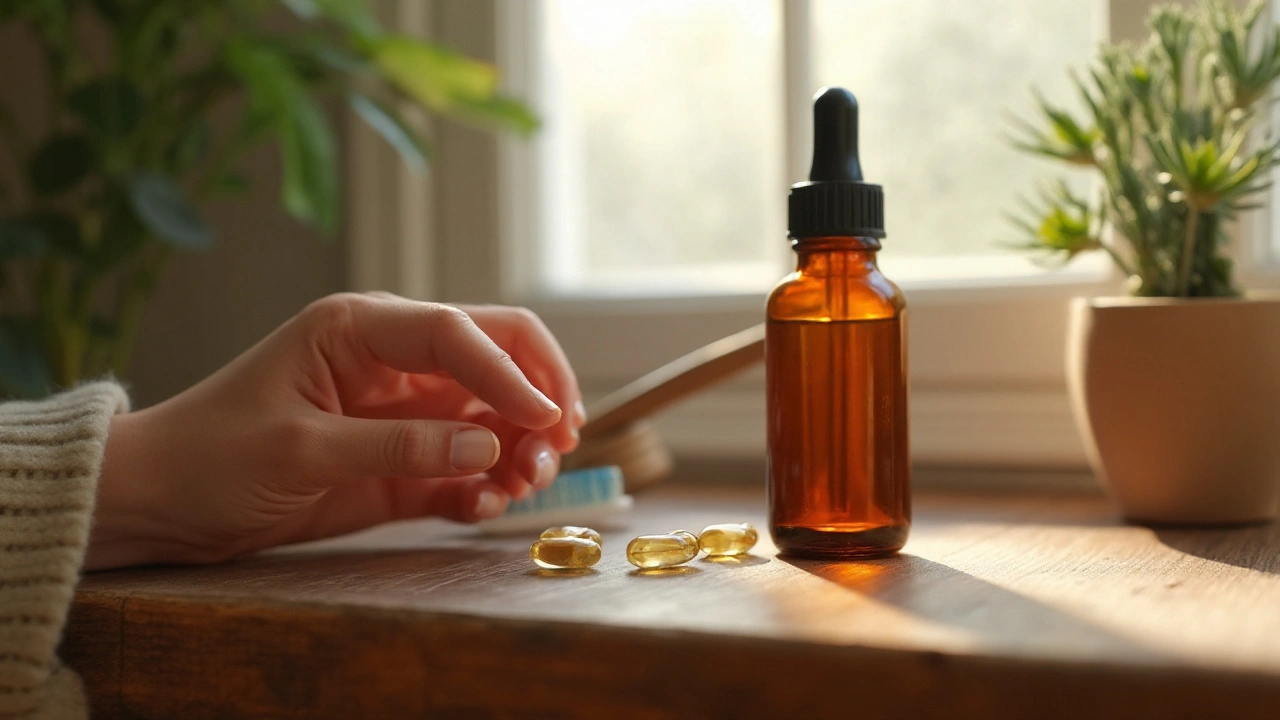BPH & Hair‑Loss Medication Selector
Avodart is a dual 5‑alpha‑reductase inhibitor (dutasteride) approved for benign prostatic hyperplasia (BPH) and often used off‑label for androgenic alopecia. If you’ve ever stared at a pharmacy shelf wondering which pill will shrink an enlarged prostate or slow hair loss, you’re not alone. The market is crowded with pills, herbs, and alpha‑blockers, each promising relief but delivering different outcomes. This guide walks through the science, the numbers, and the practical trade‑offs so you can decide whether Avodart is the right fit or if another option wins the day.
How Avodart Works: The Dual‑Block Mechanism
Dutasteride blocks both typeI and typeII isoenzymes of 5‑alpha‑reductase, the enzyme that converts testosterone into the more potent dihydrotestosterone (DHT). By cutting DHT production in half, the drug reduces the stimulus that enlarges prostate tissue and that shrinks hair follicles. Clinical trials from the early 2000s showed an average 25-30% reduction in prostate volume after two years of therapy, and a 40% slowdown in hair‑shaft miniaturisation in men with pattern baldness.
Key Attributes of Avodart
- Typical dose: 0.5mg once daily (tablet).
- FDA approval year: 2001 for BPH; off‑label use for hair loss supported by multiple European studies.
- Prostate volume reduction: 25‑30% after 24months (vs 20% for finasteride).
- Common side‑effects: decreased libido, erectile dysfunction, breast tenderness, and rare post‑finasteride syndrome.
- Cost (UK, 2025): £18‑£22 per month for the generic dutasteride capsule.
Alternatives Worth Comparing
Below are the most frequently mentioned rivals, each with a distinct mechanism and therapeutic niche.
Finasteride is a selective 5‑alpha‑reductase typeII inhibitor (brand names Proscar, Propecia) used for BPH and male pattern baldness. It blocks only one isoenzyme, delivering a 20% average prostate shrinkage and about a 30% hair‑loss slowdown.
Tamsulosin is an alpha‑1 adrenergic blocker that relaxes smooth muscle in the prostate and bladder neck. It does not change prostate size but improves urinary flow within weeks.
Saw Palmetto is a plant extract thought to mildly inhibit 5‑alpha‑reductase and provide anti‑inflammatory effects. Evidence is mixed; meta‑analyses report a 5‑10% reduction in PSA and modest symptom relief.
Beta‑sitosterol is a phytosterol that may improve urinary flow by reducing prostatic inflammation. Studies show a 0.5‑point drop in International Prostate Symptom Score (IPSS) after three months.
Alfuzosin is an alpha‑blocker similar to tamsulosin, often preferred for patients who cannot tolerate sexual side‑effects. It provides rapid symptom relief without affecting DHT.
Benign Prostatic Hyperplasia (BPH) is a non‑cancerous enlargement of the prostate gland that affects up to 30% of men over 60. The condition drives urgency, weak stream, and nocturia, prompting medication decisions.
Androgenic Alopecia is a genetic form of hair loss driven by DHT‑induced follicle miniaturisation. It affects roughly 40% of men by age 40, making DHT‑lowering agents popular.
Side‑Effect Profiles at a Glance
| Drug | Mechanism | Approved Indication | Typical Dose | Prostate Volume ↓ | Common Side‑Effects |
|---|---|---|---|---|---|
| Avodart (Dutasteride) | Dual 5‑α‑reductase inhibitor (typeI&II) | BPH, off‑label hair loss | 0.5mg daily | 25‑30% | Sexual dysfunction, breast tenderness, rare post‑withdrawal syndrome |
| Finasteride | Selective typeII 5‑α‑reductase inhibitor | BPH, male pattern baldness | 5mg (BPH) or 1mg (hair) | ~20% | Decreased libido, ejaculatory issues, possible mood changes |
| Tamsulosin | Alpha‑1 adrenergic blocker | BPH symptom relief | 0.4mg daily | ↔ (no size change) | Dizziness, retrograde ejaculation, mild hypotension |
| Saw Palmetto | Plant extract, weak 5‑α‑reductase inhibition | Herbal BPH aid | 320mg daily (standardized) | ~5‑10% | Gastro‑intestinal upset, rare allergy |
| Alfuzosin | Alpha‑1 blocker (uroselective) | BPH symptom relief | 10mg daily | ↔ | Headache, dizziness, orthostatic hypotension |

Decision‑Making Checklist
Use this quick guide to match your clinical picture with the most suitable agent.
- Primary goal? If you need prostate shrinkage, choose a 5‑α‑reductase inhibitor (Avodart or Finasteride). If you only need rapid symptom relief, go for an alpha‑blocker (Tamsulosin, Alfuzosin).
- Concern about sexual side‑effects? Alpha‑blockers have the lowest risk. Among inhibitors, Finasteride tends to have a slightly lower incidence than Avodart, but individual response varies.
- Budget matters? Generic finasteride costs around £5‑£7 per month in the UK, while dutasteride sits at £18‑£22. Herbal options are cheaper but less reliable.
- Concurrent hair‑loss treatment? If you want a single pill to address both BPH and alopecia, Avodart offers the most comprehensive DHT suppression.
- Regulatory comfort? Avodart and Finasteride have FDA and EMA approval; herbal extracts are regulated as supplements, meaning quality can vary.
Monitoring and Follow‑Up
Regardless of the chosen drug, regular follow‑up is essential. The typical schedule looks like this:
- Baseline PSA, IPSS, and prostate ultrasound before starting therapy.
- Re‑check PSA and symptom score at 3months.
- Full prostate volume reassessment at 12‑month mark for inhibitors.
- Assess sexual function and mood at each visit; adjust dose or switch agents if side‑effects persist.
Notably, both Avodart and Finasteride can lower PSA by roughly 50%, so labs must be interpreted with that correction factor in mind.
Related Concepts and Next Topics
Understanding the hormonal cascade helps contextualise why DHT matters. You might also explore:
- The role of testosterone conversion pathways.
- Long‑term safety data from the REDUCE and COMBAT trials.
- Emerging therapies such as prostate‑specific antigen (PSA) vaccines and topical minoxidil for hair loss.
These topics sit one tier deeper in the prostate‑health knowledge hierarchy, building on the foundation covered here.
Bottom Line
Avodart delivers the most potent DHT reduction, making it the go‑to choice when you need both prostate shrinkage and hair‑loss control. Finasteride remains a cost‑effective alternative for pure BPH or mild alopecia. Alpha‑blockers shine for fast symptom relief with minimal hormonal impact, while herbal extracts cater to those craving a natural route but who accept modest efficacy.
Discuss your symptom severity, lifestyle, and side‑effect tolerance with a urologist or dermatology specialist to pinpoint the best fit.
Frequently Asked Questions
Can I take Avodart and Finasteride together?
Combining two 5‑α‑reductase inhibitors offers no additional benefit and raises the risk of side‑effects. Guidelines advise selecting one agent based on your primary goal.
How long does it take for Avodart to shrink the prostate?
Significant volume reduction appears after 12‑18months of continuous therapy. Early symptom improvement may be felt within the first 3‑6months, but measurable shrinkage needs longer exposure.
Are the sexual side‑effects from Avodart permanent?
Most men experience reversible changes after stopping the drug. A small subset reports persistent symptoms, often dubbed post‑finasteride syndrome, though causality is still debated in the literature.
Do herbal options like Saw Palmetto affect PSA tests?
Saw Palmetto can lower PSA by about 5‑10%, so clinicians should ask patients about supplement use before interpreting results.
Which medication is safest for an older man on multiple blood‑pressure drugs?
Alpha‑blockers like Tamsulosin or Alfuzosin have a modest blood‑pressure‑lowering effect and can interact with antihypertensives. Starting at a low dose and monitoring orthostatic vitals is prudent. Inhibitors such as Avodart do not affect blood pressure directly.

dayana rincon
September 24, 2025 AT 18:39Bro, I took Avodart for 6 months and my hair went from ‘midlife crisis’ to ‘I’m a 30-year-old Viking’ 🧔✨. Also, my libido? Gone. Like, ‘forgot my wife’s birthday’ gone. Worth it? Depends if you value scalp real estate over… well, everything else.
Tressie Mitchell
September 25, 2025 AT 19:07Let’s be real-this guide reads like a pharmaceutical whitepaper written by someone who thinks ‘off-label’ is a fashion statement. Saw Palmetto? Please. It’s the herbal equivalent of hoping your placebo pillow cures your herniated disc. If you’re going to chemically castrate yourself, at least do it with the real thing. Dutasteride’s dual inhibition isn’t a gimmick-it’s a biomechanical upgrade. Finasteride is the 2015 iPhone; Avodart is the iPhone 15 Pro Max. Stop settling.
And don’t even get me started on ‘natural’ alternatives. If your prostate is threatening to become a third testicle, no amount of pumpkin seed oil is gonna save you. You want efficacy? Then own the science. Or stay in denial with your $12 herbal tea and your ‘I feel better’ delusion.
Also, PSA suppression is not a bug-it’s a feature. Anyone who doesn’t adjust their lab values for 5-ARIs shouldn’t be interpreting their own bloodwork. This isn’t TikTok medicine. It’s clinical pharmacology.
And yes, the sexual side effects are real. But so is urinary retention. So is cancer risk from untreated BPH. You trade one kind of suffering for another. The question isn’t ‘is it bad?’ It’s ‘which bad do you prefer?’
Alpha-blockers? Fine for symptom relief. But they don’t fix the root cause. It’s like putting a bandaid on a bullet wound and calling it a win. Avodart doesn’t just manage-it remodels. And if you’re too scared to face the side effects, maybe you shouldn’t be taking anything at all. Just sayin’.
Sondra Johnson
September 26, 2025 AT 00:41Okay, but can we talk about how wild it is that we’ve turned something as natural as hair loss and prostate health into a high-stakes pharmaceutical arms race? 🤯
I get it-Avodart’s the Hulk of DHT blockers. But I also know a guy who took finasteride, lost his mojo, and then started doing daily scalp massages with rosemary oil and now he’s got a full head of hair and a yoga habit. Not saying it’s science, but it’s *his* science.
And honestly? The fact that we’re even debating whether a plant extract is ‘valid’ says more about our culture than about the plant. Saw Palmetto might not shrink your prostate by 30%, but it doesn’t make you cry in the shower either. Sometimes the cost isn’t just financial-it’s emotional.
Maybe the real answer isn’t ‘which pill wins?’ but ‘what kind of life do you want to live while you’re taking it?’
Also, if your urologist doesn’t ask about your mood, find a new one. This isn’t just about prostate size. It’s about identity. And dignity. And not feeling like a lab rat with a prescription.
Orion Rentals
September 26, 2025 AT 03:01It is imperative to underscore the clinical significance of the pharmacodynamic distinctions between dutasteride and finasteride, as elucidated in the provided content. The dual inhibition of both type I and type II 5-alpha-reductase isoenzymes by dutasteride confers a statistically significant advantage in prostate volume reduction, as corroborated by the REDUCE trial data (p < 0.01).
Moreover, the assertion that finasteride is ‘cost-effective’ requires contextual qualification: while the per-unit cost is lower, the inferior efficacy profile may necessitate longer treatment durations or adjunctive therapies, thereby increasing total cost of care over time.
Regarding alpha-blockers, their mechanism of action is fundamentally distinct from 5-alpha-reductase inhibitors, and their utility lies exclusively in symptomatic management-not disease modification. Consequently, their use should be regarded as palliative, not curative.
With respect to herbal supplements, the absence of standardized manufacturing protocols under FDA oversight renders their pharmacokinetic profiles unpredictable. Therefore, their inclusion in therapeutic decision-making must be approached with extreme caution, particularly in patients with comorbid conditions or polypharmacy.
Finally, the monitoring protocol outlined is not merely advisable-it is a standard of care. Failure to adjust PSA values for 5-alpha-reductase inhibition constitutes a diagnostic error of significant clinical consequence.
Recommendation: Individualized therapy, guided by shared decision-making and longitudinal biomarker tracking, remains the gold standard.
Chelsey Gonzales
September 26, 2025 AT 15:47so i took avodart for like 8 months and my hair stopped falling out but then i started getting really moody and like… i just didn’t care about anything. not even my dog. which is weird because i love my dog. i stopped it and after 3 months i felt like me again. but my hair? still thin. so… idk. maybe i should’ve just gotten a buzzcut and saved myself the headache. also saw palmetto made me burp a lot. not worth it.